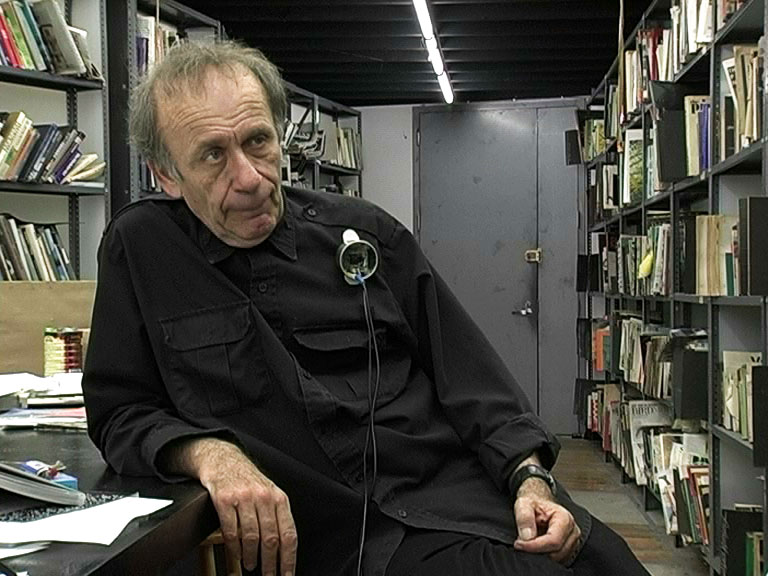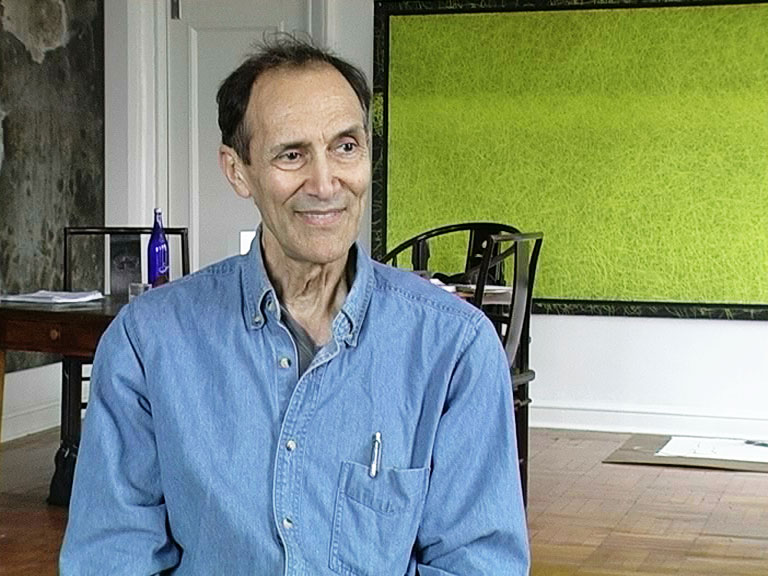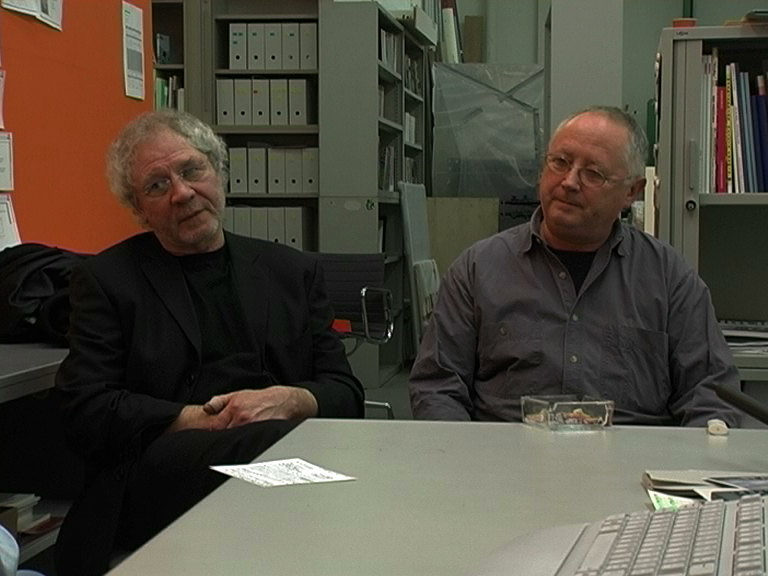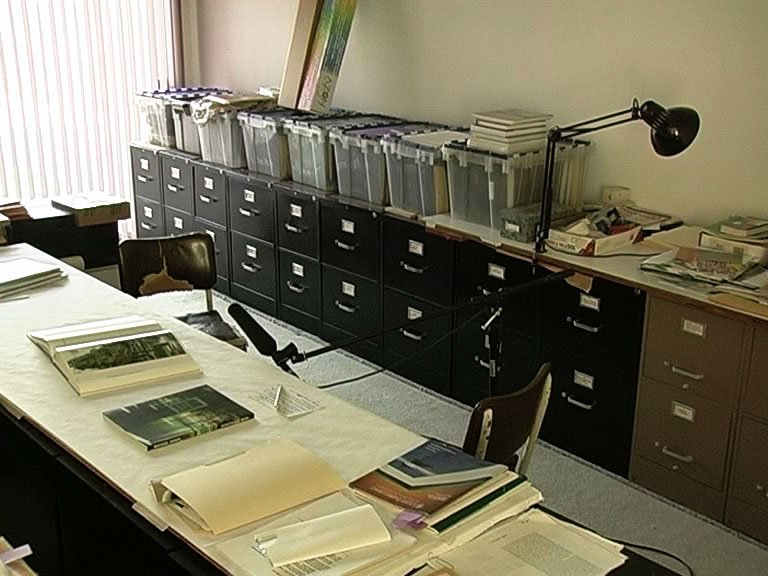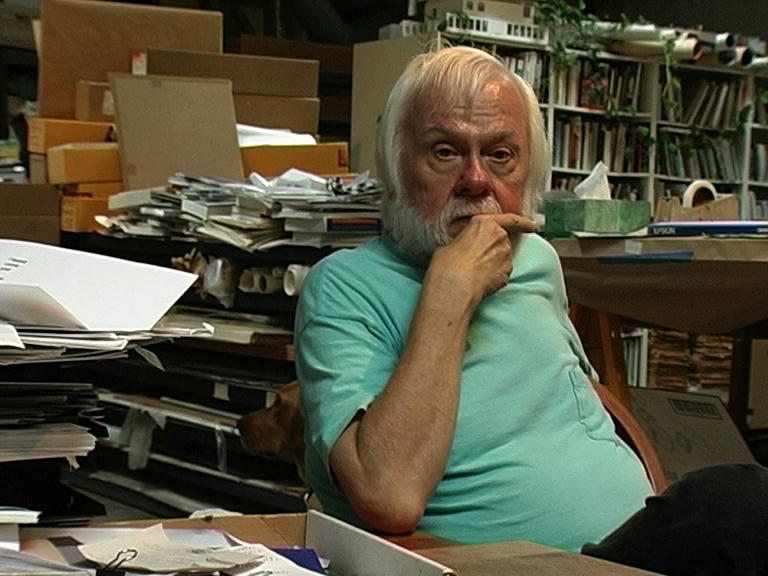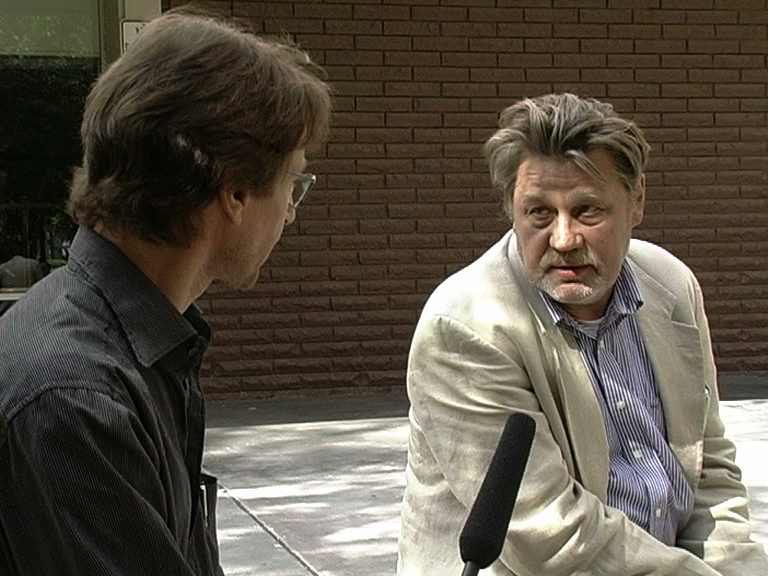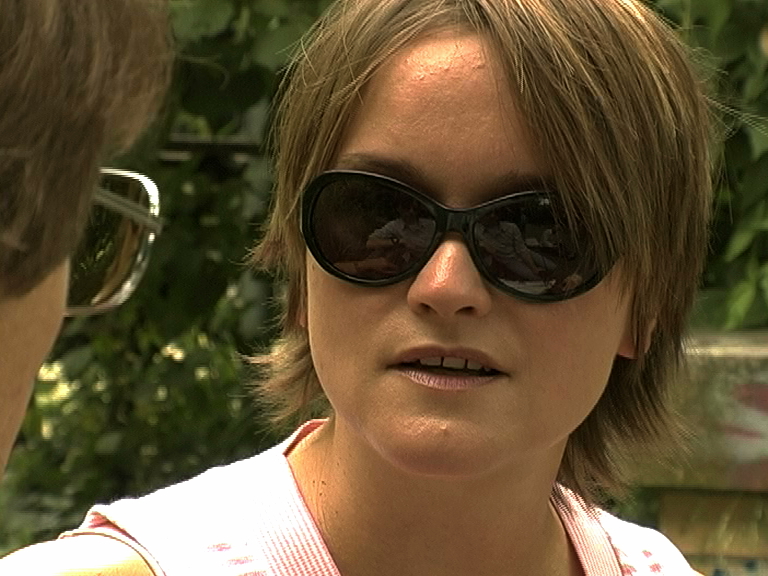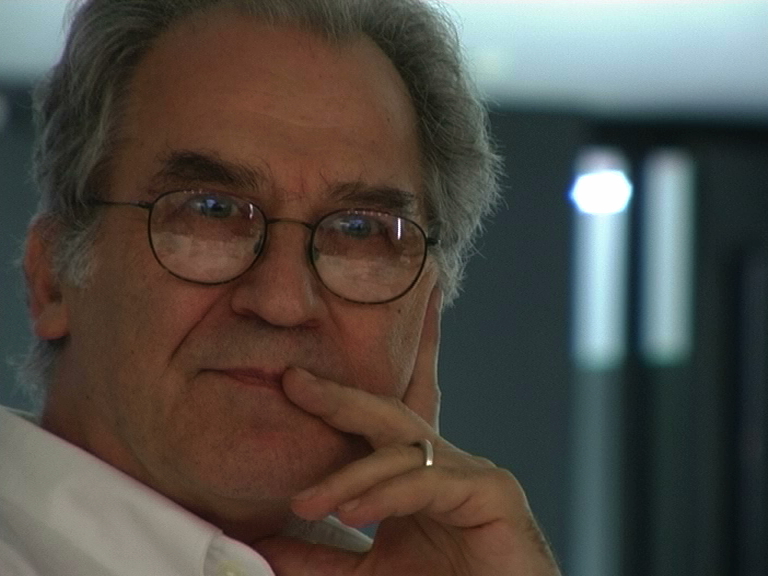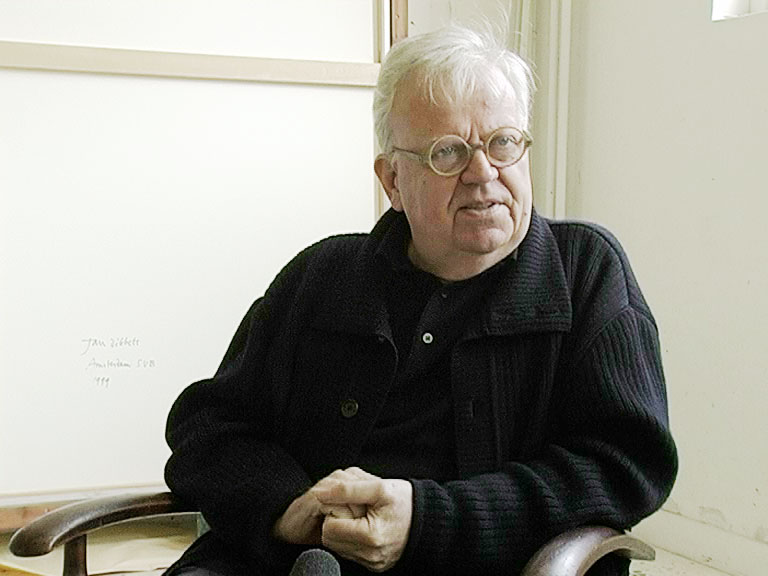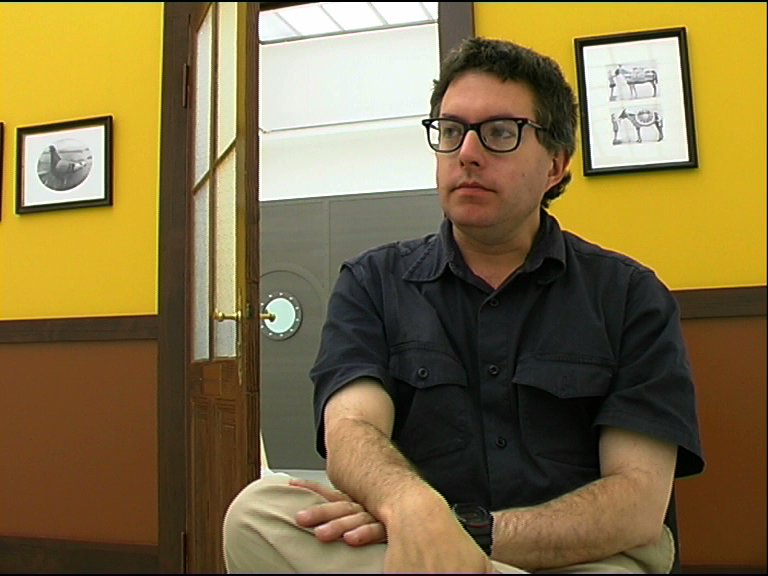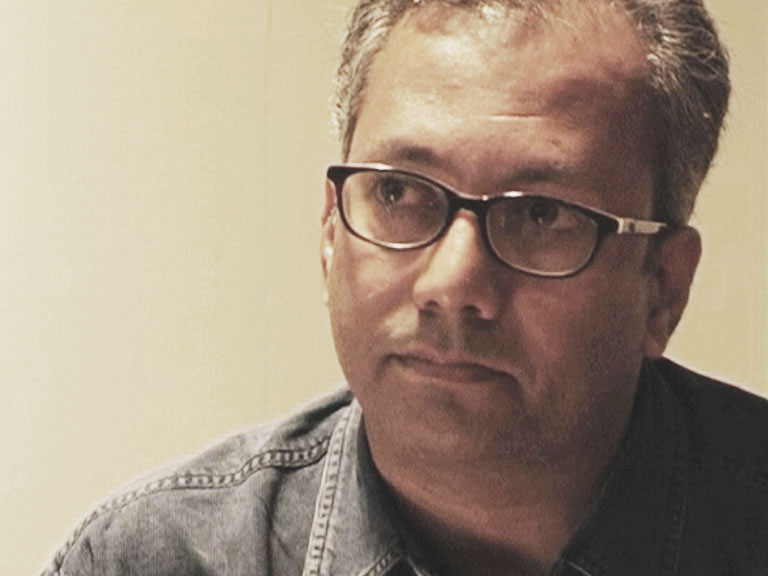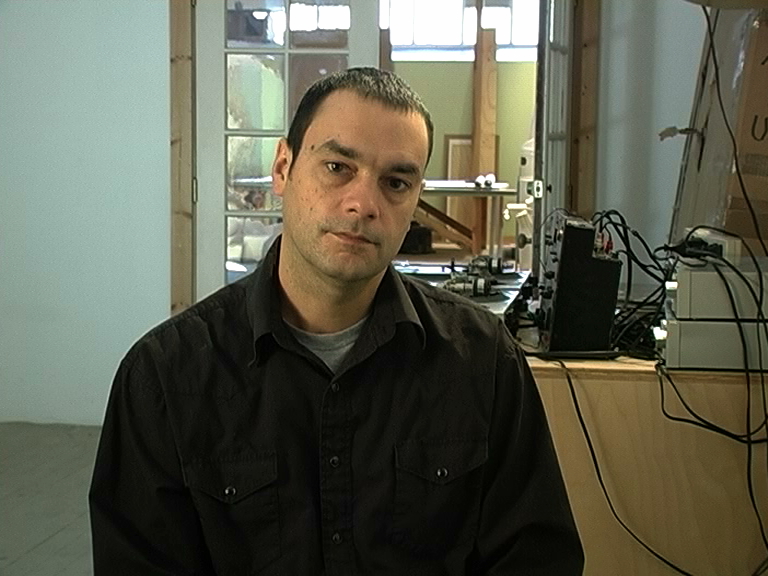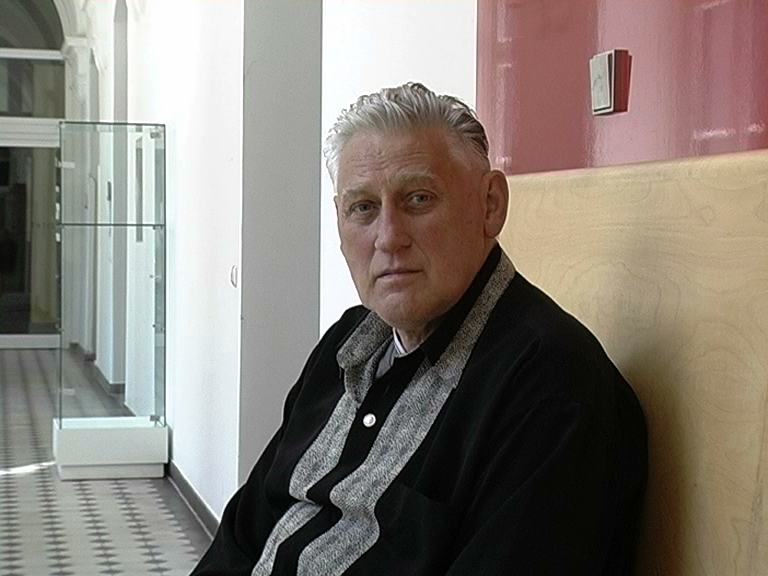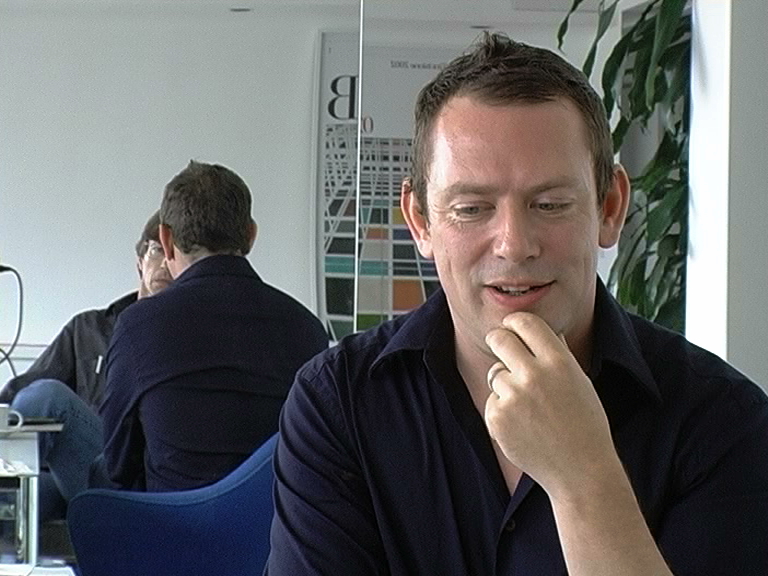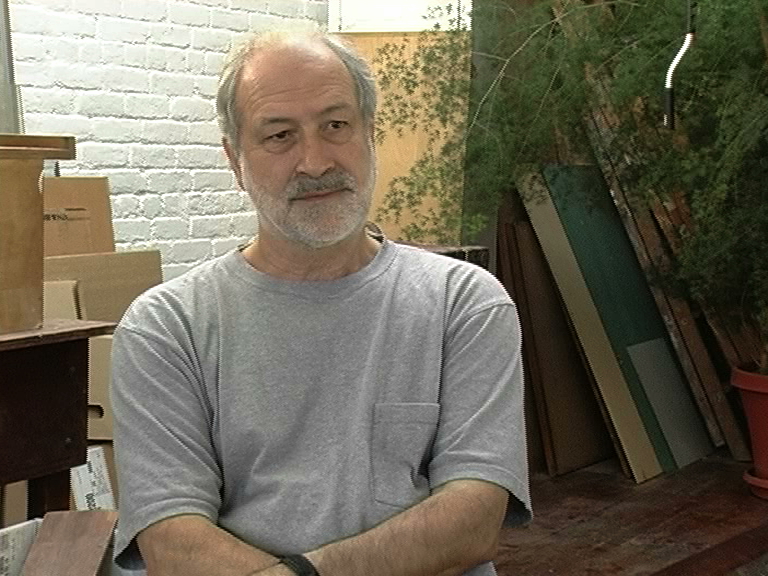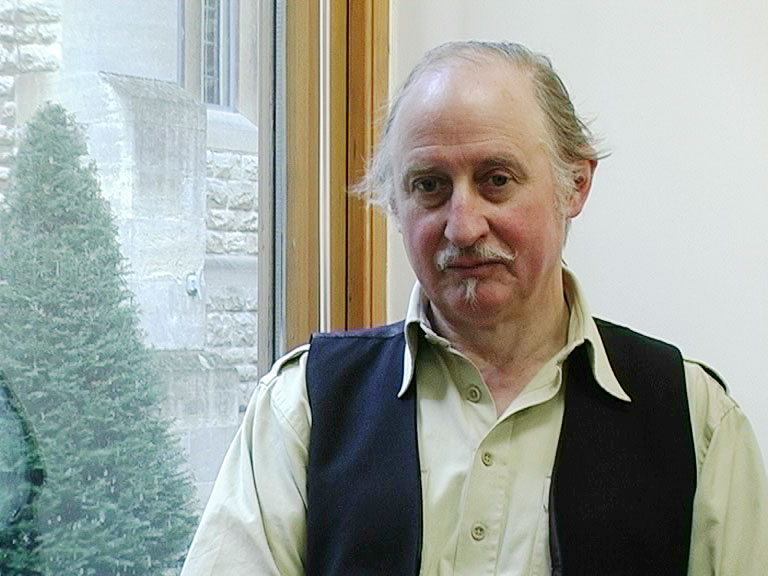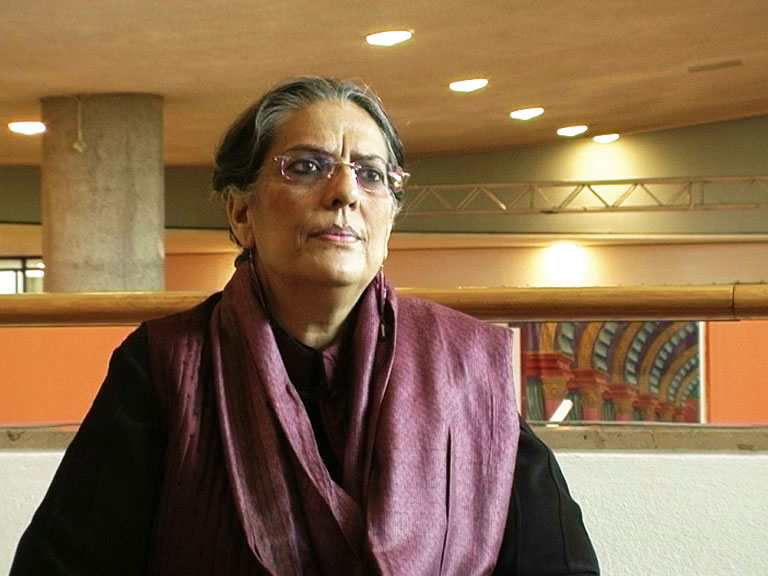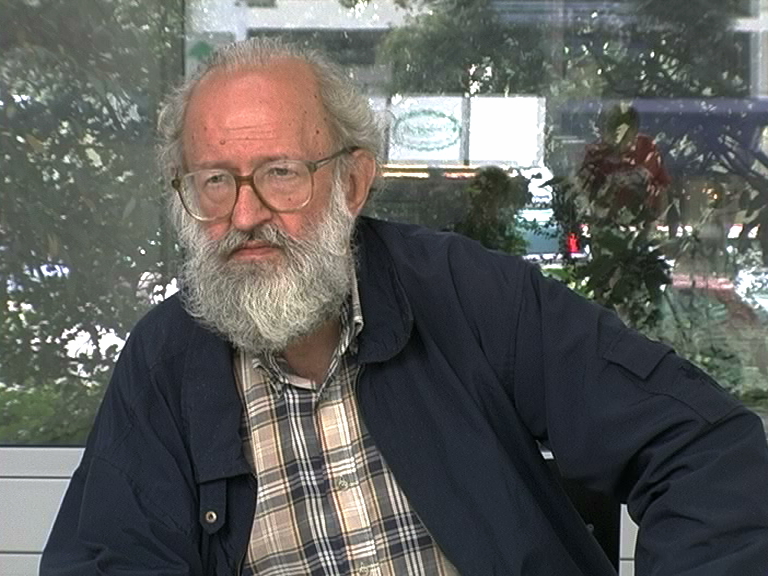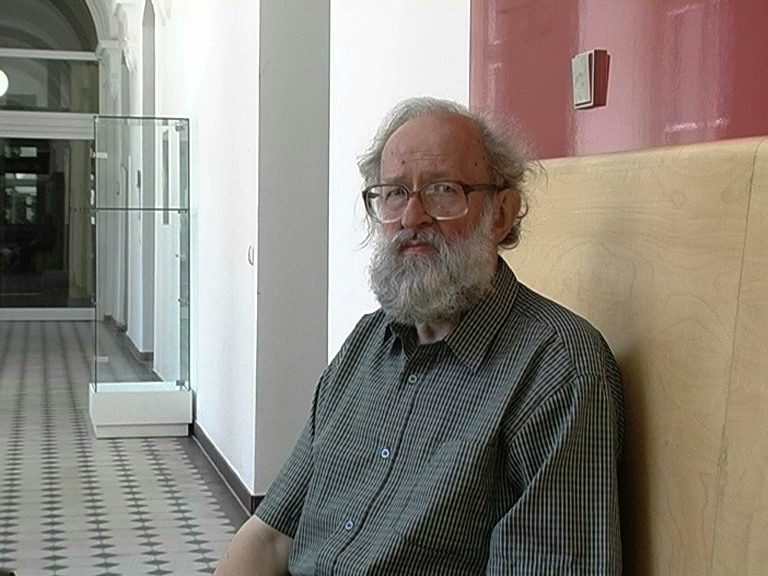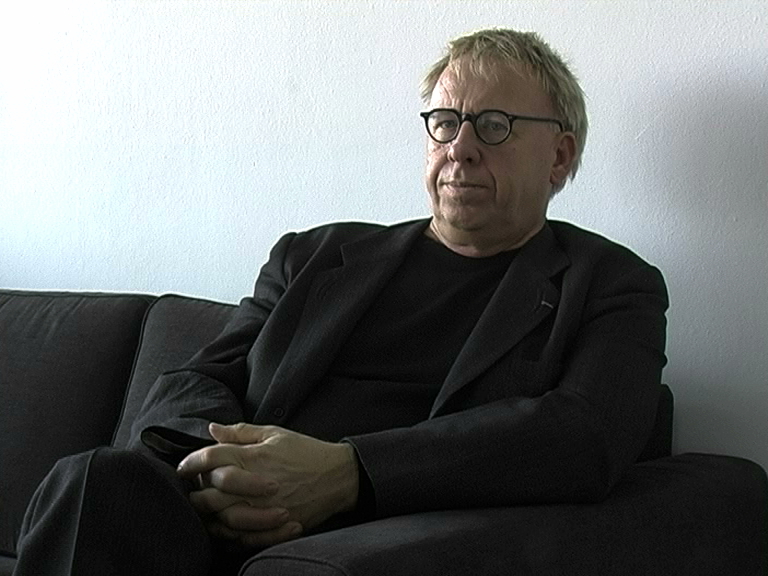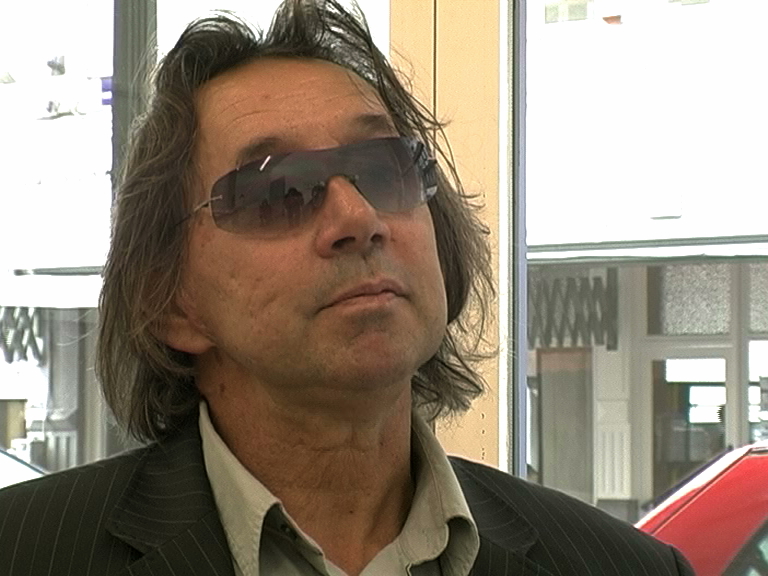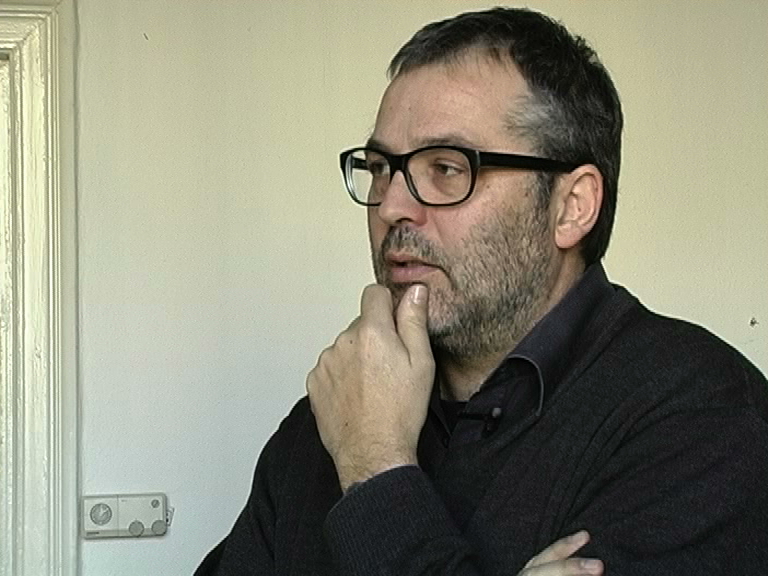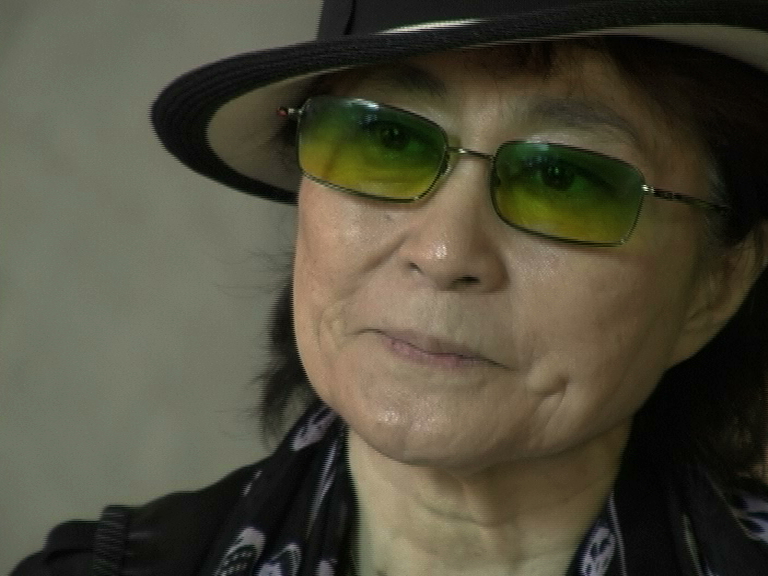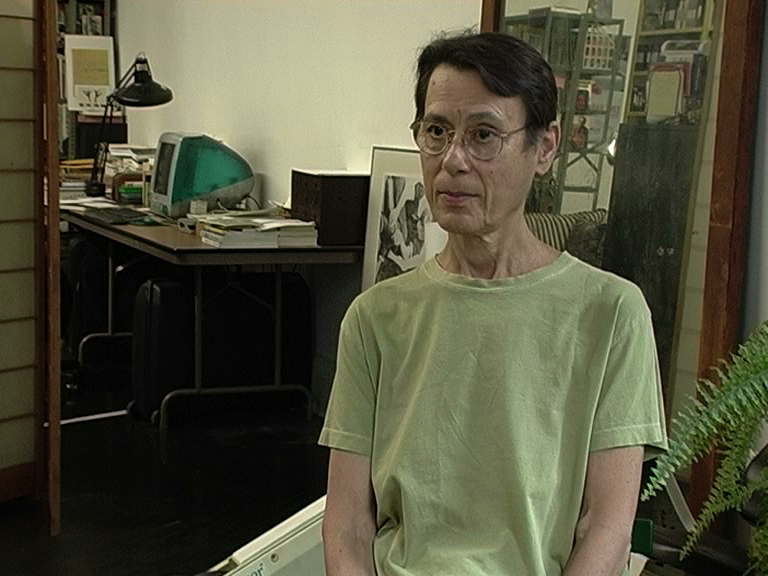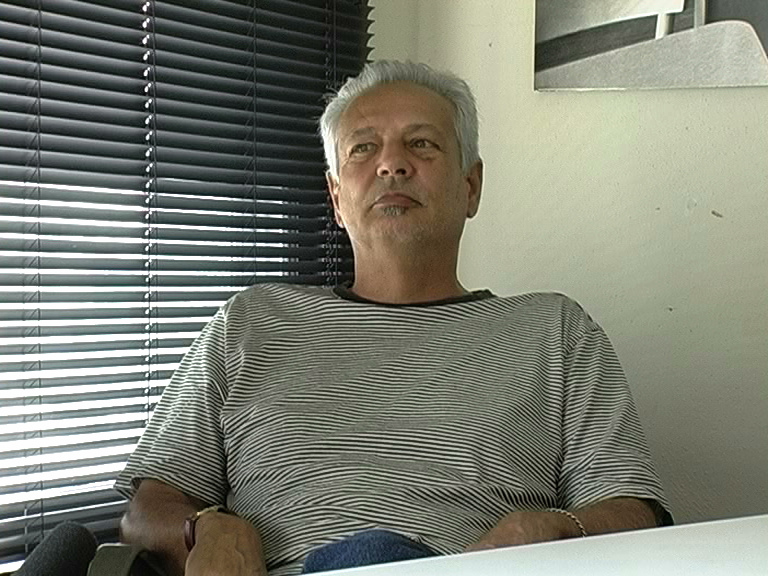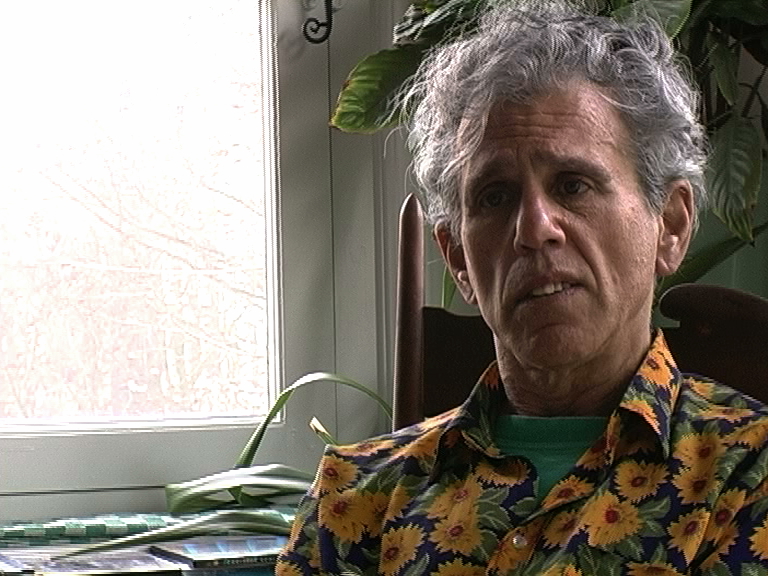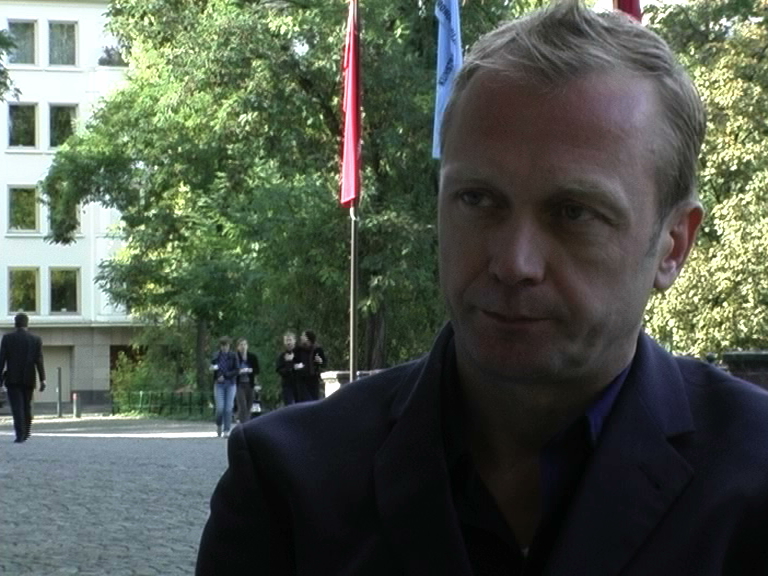S.R.: The interesting thing for me with Conceptual art is that it is conceived as something like a break in art history or the history of art, because suddenly there was this strong interest for philosophical items and for linguistic questions in art. They haven’t been there before. In this specific case also for me is very interesting that you were working from the beginning with this label „Art & Language“ in a collective situation and this label for me seemed to be always from the beginning on as I noticed that this label has a kind of programmatic model. Can you say something about that?
Mel: It’s very hard to answer that question briefly. Quite difficult.
Michael: First. I doubt very much whether A & L had ever been programmatic in any sense of a research program or anything of that nature. And insofar as it was collective we used to suggest that people considered that it was, as it were, an ordinal collective rather than a cardinal collective. So you would see him and then you would see me, but it was not a thing, which made a cardinal number of people. Some of that was connected to a critique of the mystifications associated with the modernist individual hero artist, the “Pollock” model of the artist. It seemed to us both politically retrograde in certain senses, sociologically dubious and practically probably false that work was made in the way that the stereotypes were dished out. It was in fact to us, certainly in late 60s, it seemed to us much more about the profiling of a product, to attach it to the heroic producer, than about the nature of the production itself. So there was that element of critique in that collectivity. The programmatic dimension occurred because, I think because, we began to recognize quite early, well the apparent programmatic to mention, because we began to realize quite early that the naiveties of dematerialization, ultra-minimalism whatever you want to call it, were tending to become absurd, that is to say. I suppose we began, as did many, with a sort of Duchampian position, an appropriative gesture was involved somewhere. I mean we will talk about this in due course this evening but this gesture tended to be generative of discussion and conversation, not of, if you like so, the mere dramatics of an artistic fiat. So it seemed that in as much as this, what began as an appropriative gesture, began to generate questions, if you like, ontological questions, epistemological questions and so forth and we had better address them, albeit in the amateurish and inexpert way that we did. In many ways the materials that we used were a kind of wreckage of what you might argue was an already discouraging program of analytical philosophy in some ways. I’m not sure if it’s discouraging or not. I mean there were moments when I felt then that it was something that was coming to a rather shattering conclusion. I’m less sure of that now, I think. Anyway, the only programmatic sense came of the exigencies and dynamic of a conversation, I think, and it has continued I think.
Mel: And I think that Art & Language was never really a group. It did work in a way on essays and it didn’t work conversationally and socially. I mean in my case, if I had written something I would give it to someone else to look at. It seemed the natural thing to do, and then to simply claim that particular essay or something as my own work would have been dishonest. So the thing that was worrying me about what you said first is the notion of Conceptual art being a complete break with previous aesthetic positions, which is based on the idea that we used to have particular forms of art and then, with Conceptual art, we now have “art in general”.

Michael: There was a post-modernist moment…
Mel: This is a seriously worrying thing I think because, well I don’t want to get into the problems of art in general but there was never, what I understood from the beginning, it’s silly to have an argument about what is Conceptual art, what isn’t Conceptual art, because nowadays more and more things are being expanded to be included in Conceptual art, including Fluxus and stuff like that which in my original understanding of what we were doing was that it was completely against stuff like Fluxus. That Fluxus was putting out something where anything could be art. And it seemed to me that if you had a situation like that where anything could be art, okay anything is art, everything is art, you might as well start looking for some different kind of criteria. And the logic, some of the philosophical terms which were mainly introduced by Michael, I must say, and Terry Atkins to a lesser degree, was a great liberation. Because instead of talking about aesthetics, beauty and contemplation you had to start thinking in terms of epistemology, ontology, indexing, a whole different kind of vocabulary came in. But all of this was driven, I think, by a kind of desperation as to what to do after modernism’s nervous breakdown, after modernism was almost laughable in the early 60s. And it was driven by what to do, how to work with the wreckage. I never saw it as this great kind of “wow, we‘ve got Conceptual art now, art in general. We are not stuck with any kind of the old mediums.
Michael: No.
Mel: We are, I think, stuck.
Michael: It had a specific critical, insofar as I was involved and you were involved, there was a very particular historical critical dimension to it. I mean the issues that were at stake for us were connected to the fact that in our – remember we were relatively young – but in our even younger lives the great influence on us, the great world to aspire to connect with was that world, if you like, of the attenuated modernism one associated with Frank Stella or Larry Poons (?) or whoever or even Noland but Greenberg or was still a voice, was still dominant, even in the form of his pupil Michael Fried and so forth. I mean I like Michael Fried a lot but at the same time that dominance of that voice was what seemed to drive one‘s critical activity. And that brings one to another point, which is that there’s a very specific connection between those early moments of Conceptual art and painting and the whole ideological apparatus, which surrounded painting. I mean it’s a perfectly cogent argument to suggest that certainly a good bit of the early work produced by us was, if you like, intended to syndicalize the space of painting. It was either to occupy space which painting had previously occupied or, if it didn’t occupy it, to draw attention to the fact that it could, in some sense. In so far as we produced all this, some of the discursive material there was always the problem of how to exhibit it. This was not a moment then in which one really tried to discover ways, in the words of our dear friend Daniel Buren, “to penetrate the space”. Those things weren’t really an option anyway. But one at the same time it had a rather shame-faced approach to this syndicalizing process. But it definitely felt like that, didn’t it?
Mel: I mean I think in, I suppose, the mid-60s there was plenty, plenty of mad art around and it was never called Conceptual art. And I think we were so much on the very end of that mainstream modernism that we wanted to, in a kind of really horrible, it seems horrible to me now, way we wanted to stay in the same space – as modernist painting. We wanted to stay in the same space, we wanted to keep the mainstream and not have this kind of diversified mad art which could easily be dismissed as being Dada, Hippie-Dada, late Surrealism.
Michael: It certainly was never on our agenda. But the fact is it changed very rapidly. To try and argue cogently that the sort of discursive operations that we got engaged in in the late 60ies would or could be readily be reconstructed as having some sort of airlines to what you call mainstream would have been a pretty difficult thing to sustain. The nervous breakdown did occur. You can’t have the mainstream and nervous breakdown simultaneously, except you want to.
Mel: …and we wanted to.
S.R.: But when I put it right, can you find something, can you find a practice maybe that is or was a strong influence on your work. For example you were talking about post-, late-Minimalism or critical opinions on late surrealist influences or practices. So if you would focus – do you have something like an influence in the history of art or would you say no, we conceive ourselves as a part of the whole modernist movement?
Mel: We both do and don’t conceive ourselves as being part of the modernist movement and there were a lot of influences. I mean for example Judd, Morris, Robert Smithson. You know their writings as well as their work. The fact that a lot of that writing came out in “art forum” was read in England, where the work wasn’t seen, just photographs. Those were the first artists in Artforum who seemed to plausibly be able to defend their own work. So there was a lot of influence.
Michael: And as a non-artistic influence in the 60s, the later work of Wittgenstein was published. And this was something of a revelation in the sense of one of the implications of that work was that we could not easily bifurcate or separate our perception and our description, that seeing something and describing it were usually so interlocked as to make it quite frequently impossible to tear them apart.
But these influences again, it – someone who doesn‘t like Harold Bloom – but there were many. I mean Barnett Newman was extremely influential, in as much as Barnett Newman had a rather pretentious approach to explaining his work for example. It was rather interesting. There were many things. It came in large measure from – certainly for a person who was not American. First time I went to the United States was in 1965. I was 19. But the “Weltanschauung” from which this material erupted in our minds – with the exception of the Wittgenstein connection – was in American painting, was in Modernism, was in the Greenbergian hegemony and so on. Clement Greenberg, negatively or not, is therefore a powerful influence, on what drove, negatively, the conditions of our production in the mid 60s.
Mel: I mean, even dematerialization which we practiced of sorts for a moment…
Michael: It drove me crazy.
Mel: …they, Terry and Michael did a work, which was called “The Oxfordshire Show”, which was declaration, – excuse me –…
Michael: It embaressed me.
Mel: …which was the nomination, I suppose, of a block of air above Oxfordshire as a work of art. Now, it was invisible. The only way that you could make it count somehow as a work of art, was to write about it. I mean, the point is, was the block of air the work of art or was the text written about it the work of art?
Michael: That’s what I said, the art of appropriation immediately became problematic. And then if you write about it, in what particular genre do you write about it? Do you write about it in terms of chemistry, physics, of a sort of poetry? I mean, the thing that drove me almost to distraction about a large number of American artists who were involved in Conceptual art was their assumption that their language was transparent. That you could make this act and it was a perfectly transparent thing. Again through the agency of people like […] Willard Van Orman Quine, Wittgenstein and so on, what I began to realization that one’s language was opaque, was increasing. And it seems entirely invidious to expect to have a critique of, among other things, the institutions of art, and to have no critique of the apparently and fraudulently transparent language that they thought they transacted its business in.
Mel: You see there’s a couple of ways you can point to a column of air over Oxfordshire as being a work of art. You can get the sentence and put it in a frame and say there’s a column of air over Oxfordshire and it’s a work of art, and sign it. Or you can think about how and what the conditions are, whereby you assert this column of air over Oxfordshire as a work of art and then things start getting complicated. And then you get to somebody else and they have something to say and then a whole conversation starts, not just something which is a pictorial replacement of a painting, but a conversation starts.
S.R.: My opinion or my understanding always was that this term of dematerialization is totally misleading.
Michael: Absolutely. A piece of paper is still a piece of paper for God’s sake.
S.R.: And if you talk about dematerialization often the context, the epistemological context was lost. Because they always talked they don’t paint, the artists don’t sculpture, now they think. The artist before didn’t think? It was totally crazy.
Michael: Well I think the point, again, we’ll talk about this later but, the point one has to think about is… It brought up by Richard Wollheim in „Art and Its Subjects“ in 1969 – we discussed it lengthily before but not as expertly. But his point was that if you want to do any aesthetics at all you’d better get the ontology figured out and the aesthetics would to a degree be clarified if the ontology of art was clarified. It just so happened that at that moment that Wollheim wrote so or published „Art and Its Objects“ that the ontological game if you like that one was playing as an artist was getting a rather difficult and strange one. His position would have been always that there must have to be some material embodiment of the work of art and that that material embodiment meant that the viewer in principle, any physical attribute to the work of art was potentially the aesthetic significance to the viewer. [coughs]
Which in my view is a mistake. But at the same time it confronts, and this again we’ll talk about later, it confronts of course one or other of the various forms of the institutional theory, the theory of which the Duchamp bottle rack is the paradigm. And I think in many ways we are still fighting that battle. I don’t think it’s solved. The problem isn’t solved. Well I haven’t solved it, maybe others are cleverer than me, but…
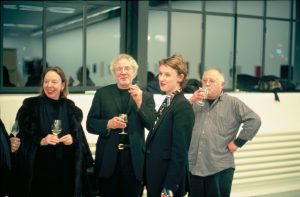
S.R.: My next question is, it’s maybe a little flattened maybe. It’s: What is your aim with your practice? Can you figure out something like an aim?
Michael: Art & Language and télos. The best I can manage is: if we stop it would be as if we had never begun.
Mel: We always have things to do.
Michael: And there is always, I mean I don’t know how I feel about his work but we are engaged in a kind of activity which could be described, as I said, in Luhmannian terms as a kind of practice of re-description, of indexing re-description. The point about the re-description is that it tends to give you perhaps the only set of conditions in which you can start reflecting the conditions or circumstances in which you are doing it. There is a very aegis, or one might say central to the practice, a kind of memory of realism or a kind of sense that realism in one or the other provides a kind of discipline. It remains an art of describing in some ways. But given the extraordinary expansion of rather naive expansion of materials that can be considered, one finds oneself dealing in a somewhat reflexive universe. But I don’t know again, if we take many periods of art, I don’t know any really that aren’t essentially reflexive in some significant sense. So I haven’t to make an apology for that although there would be those who think, in socialism might come in one art work. Who would criticize us for that, for not being, how shall I put it, current enough or political enough in some direct sense. I’ve always had a great misgiving about the idea of the artist that centers stage-front in political transformation and other things. I rather think that we deal in redundant political materials largely and there are moments of course when we have our ideological place.
The other thing is, as Mel said earlier, we were very struck by, I hate to bring this up, God forgive me for bringing up Walter Benjamin. But his idea of the essay, the idea of a project which ran out of steam at some point, but which nevertheless had some sort of discursive or fruitful relationship with some other set of possibilities. Instead of having a great sense of the oeuvre one has a sense of the essay, seems that your ambitions don’t go to having some a grandiloquence of what your position might be historically, but your ambitions extend to finding another essay to engage in. It’s as myopic as that.
Mel: That has always seemed part of the morale of Conceptual art and to keep the morale of Conceptual art going is I suppose one thing that we sometimes do…
Michael: What Conceptual art did you have in mind?
Mel: Well that’s the point, isn’t it.
Michael: …Because remember, Conceptual art has developed its purists.
S.R.: My next question is exactly about that. I want to ask you, do you think the conceptual paradigms are still in function? And it’s also the question: What are the conceptual paradigms?
Michael: If you talked to most of the artists who might be included in, I think they don’t know how to answer that question. I think one artist would give you an answer in particular that would be Joseph Kosuth. Joseph has the notion that artists make meaning. He also, I suspect, labors under a dreadful misapprehension regarding the role of intentionality in the production of art, I mean, to the extent of being in danger of committing a fallacy which was abolished some time in the 18th century, an intentional fallacy. I think that there were those who saw, for a moment he saw Conceptual art as “white collar” art as distinguished from blue collar art which was involved in dirty things like painting, manual dexterity. I remember being quite hot for the idea that one did not need a studio, don’t need a place to work. The place was connected to the conversation taking place. This is okay when you’re 20, 22, 23. I mean one has no regard for the historicity of one’s practice. One should better not have any regard for the historicity of one’s practice. This is sort of natural avant-garde that occurs to young artists in the sense that they can’t afford expensive materials. They can’t be self-regarding or shouldn’t be self-regarding in certain ways. And therefore a sort of aesthetic emerges from that, a sort of A4-Xerox, or photocopy in those days. An aesthetics of sorts, a taste anyway can live or own that, and one can make a lot or a little of that, as one wishes.
Mel: I suppose some people would answer that question, I’ve been just trying to think about it, by saying that it’s actually associated with a particular historical period. And that historical period was between 1967 and 1972. But I don’t think I could really defend that all that well. What I mean is, it had a historical and transitional character during a particular period. But I can’t really identify that with any particular works – which is okay which is why I would have to call it a historical period.
Michael: But that transitional or provisional character which grew out of, if you like, complexities which were immediately presented by an appropriative type of practice that produces conditions in which purism really cannot flourish, because if a practice is self-transforming in certain senses, which is not disconnected to the modernistic program in certain sense. If it is self-transforming then all bets are on regarding the appearance of the work. Is the work that is produced merely indexical in the sense of merely being a trace. Or does it arrogate to itself some appearance, which serves to identify it in some stylistic sense, whatever that might be. These questions remain open, or had to remain open at that time, and anyone who has tried to perform any sort of closure on that is, no doubt, they have reasons, but my own sense is that they were those who tried to continue the morale, as Mel calls it, of that moment. And those who gave up and became the police and saw their role essentially as policing that rather limited set of ideas that they managed to feel important about between 1967 and 1972. I really don‘t think there is a [coughs] If you are searching for differenti here you’d better not search for them in the appearance of the work even though there is a characteristic appearance of that work which is typing and typesetting, blow ups.
Mel: And as the people we think of as conceptual artists have grown older, their work has tended to become much more grand and installational. So what was once a piece of A4-paper, a sentence on an A4-paper now occupies a whole wall. So in a sense a lot of the early character of Conceptual art, as I understand it, had a kind of homeless quality. You didn’t know where it belonged. Did it belong in a book, on a wall? Was it his, was it mine? All of those characteristics have completely gone because the work has been taken into the installation, into the museum. So it’s its uncertainty about its place which was part of its discursive vividness in the first place, has disappeared.
Michael: But you should also admit…
Mel: I admit doing that myself.
Michael: But it’s not just that. It’s a question of making the admission. It’s a question of saying if we have some reason to give some degree of physical embodiment to the work you might ask what that might be – it still does not constitute anything like an identity that could be purified. I think that’s a fundamental mistake in those artists who have sought to do it. It’s not just a mistake regarding the morale. Actually it’s an ontological mistake. Because you can only, since these people are dematerializers and still see themselves as that, how the hell can you be a purist except in terms of some form of physical embodiment of that? I don’t see how you can be. They are in a paradox and they‘d better shut up. [laughs]
S.R.: I asked Dan Graham the same question and he was talking about some younger artists who define themselves as late conceptual artists or something like that. And he was really going on them – really bad. For me it sounded much more like a style question.
Mel: Well, I mean Conceptual art is a generalistic term now. It’s replaced modern art as being the thing that scandalizes the public.
Michael: If you read a newspaper in England you have even critics now talking about Conceptual art. They are entirely unaware that there was this moment in the 1960s, entirely unaware. The “art has no history” slogan. They confirm it daily.
Mel: There is a strip in a satirical magazine in England, it’s called Young British Artists. They are celebrating New Year and they are saying: “Out with the old and in with the new”, and in the next frame it says: “Except Conceptualism, of course”.
Michael: Whatever that is. It’s now become nothing more than a journalistic category for anything that isn’t basically painting and sculpture.
S.R. That’s why I asked this question. The following question is: In an idealistic way, how could a new or contemporary approach be realized in differentiation to these general heroic strategies that define themselves as basically Conceptualism? Do you think that there can be something like a contemporary approach, a new setting, a new epistemological point where you focus on?
Michael: Again, it comes down to, given the extraordinary changes, when you think of how many museums have been built, how many Kunsthallen there are, how many curators there are, how many managers there are, how many distributors there are, how many sponsors there are – you now are bound to think of a great deal of art has been the dream work of the triumph of global capital. The question is, is there a way that we can imagine resisting that co-option. I can imagine it, I don’t know whether I can do it. And I think the game, if you like, has turned into one that perhaps has never deserted us but it’s become one where, if you think – as an argument –, if you think of a Buren in penetrating this space, and it does immense credit to the architect, the curator, the what ever. It’s connected and it’s plugged into that system.
Think, on the other hand, of Las Meninas in the Prado. Las Meninas outranks the Prado. You could argue that its internality is so great that the Prado is sucked into it rather than it into the Prado. Can we conceive of or can we think of a way of recognizing that this institutional power that has been exercised for at least the last twenty years and at the same time introduce art with a significant internality – I don’t know. But it seems that its the way. Certainly that puzzle we’ve got to try and solve. In other words, although the arguments for absolutely Wollheimian internality, material embodiment, are, I think, generally false or unsustainable, at the same time that argument still comes as a powerful critique to what have been the cultural consequences of institutional developments. And Conceptual art has been one of the chief instruments which brought in or created conditions in artists minds for this institutional explosion to occur. It’s often quite an interesting Gedankenexperiment to think, to use a hypothesis, what if we hadn’t had Conceptual art and at the same time we’d have the global capital we have and the kinds of distribution networks etc. Would they have been able to do it with something else? I suppose the answer is yes. But it still remains a question in how far Conceptual art is really implicated in that system.
Mel: I eman, for example… It’s much cheaper to have an artist go and live near a particular Kunsthalle for a month and create a work there than ship work from studios. A lot of that was, I suppose, enabled by the notion that Conceptual art didn‘t need a studio, they can work anywhere and so on. But I don‘t know…
Michael: It also created absurdities and scandals. One of the things that people are quite terrified of now is to see things as vacuous. We have so many Deleuzian rhizomes to follow that we might as well quit. Again, if we have to quit and we simply think the entire artefactual world is something which we can rhizome together, then fine, but if we do that, as Mel suggested earlier, it doesn’t follow from this, that we’ve got rid of art and that we’ve reached voices, predicted moment. It means that we have to find some other set of distinction to make. And forms of resistance.
Mel: Some of it has to do with what kind of presuppositions you make about your audience. Because I think a lot of early Conceptual art didn’t see itself as having an audience in particular, it wasn’t facing its public. It wasn’t just passively facing its public. It was trying to make social relations, in many cases, with other people and it was trying to make those into co-producers. If you could figure out some way now to make people into co-producers then that would be probably some of way of going about having Conceptual art again. Sometimes we thought that Conceptual art was a bit like amateur painting.
Michael: In fact at one stage in the 80s we conceived work in which we used the purified style of Conceptual art to promise to paint amateur paintings. We thought that was a promise. People didn’t get it. [laughs]
S.R.: The question of resistance is a big question. Because after the 80s where even affirmation, after appropriation, affirmation of capitalistic strategies were conceived as subversive. So it‘s… I’m much more coming from a very political, critical art practice in the middle of 90s, beginning of the 90s to the middle of the 90s. And we made some big events, invited many people and so on. We had exhibitions only for one hour and things like that. So for five days during the art fair in Cologne we had 50 exhibitions or so. Everybody was for two hours or for three hours, he could put a painting or whatever. And there were a lot of discussions, discursive work and political presentations and so on. And the interesting thing is that out of this group there were only one or two people at the last documenta, of the organisational artists. But of the other artist who were invited there were some invited to the documenta. It was only one step becoming an artist. Joining this very critical practice, doing this for one summer or so and then the next step.
Michael: It was a tactical move.
S.R.: Or if you see somebody like Matthew Barney. His strategy is containing the point that when the first exhibition from his gallery is going on a world tour everything must be sold. This is part of the strategy. That everything is sold. You can only see the works and everywhere is a red point, if you see it in Tokyo or somewhere else.
Michael: We received a kind of questionnaire from some researcher at Centre Pompidou. And the last question she asked was, is it possible to be subversive or is it mainly necessary to be cynical? Cynicisme ou subversion? The only reply I could conceiving in the short time available to me was that as far as I’m aware most soi-disant subversive activities are cynical. This extreme bind that we seem to be in since the various apostles of pragmatism from Rorty to Derrida to Deleuze and the growth of a kind of academy of cultural studies, of the universityfication of certain sorts of practices. We have now a colossal middle-brow. So if I turn on the middle-brow radio station in England, “Radio 4”, and hear an arts discussion program, no discrimination is made between the world from which Henry Moore comes and the world from which Tracy Emin comes. No distinction is made. They are merely famous artists with a profile of some kind or another. This is an extremely deleterious effect. You can say, I’m artist who works with that or you can say, “Okay get my Adorno done”. I say “fuck it, we‘ve got to put the contact back”. This is very simple. This is rubbish. And at some point my patience run out a long time ago. My capacity to divise didn’t get any better, but certainly, grumpy Adornoishness seemed to me in many ways preferable to the fraudulent democracies we are presented with now. I’m no huge fan of Adorno. I don’t know how to be a fan of Adorno because I can’t understand a good deal of Adorno. But what I can understand certainly seems to me to be still asking some questions. And that’s a way to go. Go back to the better texts, in some sense or another. And I think some of the younger people are or find it possible to do that. I mean it’s also very paradoxical and strange. When we had the misfortune to have to write a review of Gilles Deleuze’s book on Francis Bacon, “The Logic of Sensation”, this was not a pleasurable read, it was very well written. But actually Deleuze’s taste, the affirmations in his text are of tachisme and rudecent painting in certain regards and Beckett and a few existential bits of boiler-plate, but Deleuze himself has quite a conservative taste in art. Not that that’s paradoxical, what I’m saying is that Deleuze got on Guattari’s injunction that we have to find out a way art works. It’s not in itself clearly an injunction to see the rhizomic world that they argue for as constitutive of circumstances in which art can be produced. And I think there is something that goes edging round it and is never very clear. I think there’s a lot of shame in for example failing to see the point in things. I’m old enough for it not to bother me very much. But I think I remember the pressure is on us in your thirties to be convapuative and so forth. Again when we were younger it was not a pressure because it was not heavily professionalized. There weren’t the strategies and now you have circumstances in which young artists work on the best possible materials. It seems something indecent. Peter Bürger notwithstanding. There is a natural Bürgerishness to young artists. Now we’ve got the artists working on acid-free, the finest most expensive papers, archival quality stuff and so on. There’s something comic about that.
There is an element which is absurd in Conceptual art, it was always something that struck us frequently, that it was less than it seemed. As artists we were full of imposture, ludicrous imposture. There were circumstances in which we were never ever going to be able to lose that sense of imposture. So the best thing you can do is reflect upon both its horrors and its joys. That’s the way to go. The only thing I can say is: How do we make work that has significant internality, which at the same time is aware that it can’t merely by becoming a reactionary thing like a painting. Now, here it is [makes a gesture with his hands]. How it can both, turn its self-description to the conditions in which it finds itself, but at the same time preserve a degree of internality? It’s a project that we are banging our heads on the wall to figure out. I don’t know the answer. You can make little essays, little moves forward at best.
S.R.: Maybe one very important or very interesting issue is that philosophical people like Deleuze or Derrida – when they think or work on art they always have such a strange cosmos of reception that we maybe don’t understand why they take this conservative practice…
Michael: No, it seems unintelligible given the philosophical import of what they say quite frequently. It’s quite strange. But I think that also, we shouldn’t say this in public, but philosophers are bloody awful readers of art. The only one I know who was really good was Wollheim. He could look at painting quite well. But philosophers like a Magritte, don’t they? [laughs]
S.R.: Of course.
Mel: Yeah, of course.
[coughing]
S.R.: There’s only one question and…
Michael: And it’s a big one [laughs].
S.R.: It’s an easy and maybe a little bit funny one: How would you describe your typical daily work as an artist?
Michael: What do you mean, you could put it in that sense of the absurd diary: get up, put on clothes, kiss wife…
Mel: Say, Oh Fuck, I‘ve got to go to the studio…
Michael: …get in car, drive to studio. Basicly it‘s what we do.
As you get to be antiques as we are you develop not only a kind of future but you develop a past, which comes back and bites you. So you are often servicing the past as much as you are servicing your putative télos.
Mel: And you can’t do nothing about this past. It just gets bigger and bigger.
Michael: It comes after you. So you have to have a studio because you’ve got to service the past. What do we do at the studio. I’ll tell you a joke: Charles Harrison, I got in auditorium with him to work on a literary project, came into the studio the other day. And we were doing a certain amount carpentry and at the same time writing the obituary of Richard Wollheim. So I said to Charles, well take your choice, you have to come to the carpentry and obituary department of the studio. [laughs] The studio tend to be – I suppose Marx might have approved in some ways… We certainly engage in a large number of activities for the physical production of the work on the grounds of a kind of… Okay now we’re doing obituary and carpentry but doing the carpentry is connected to a kind of self-denying ordinance or something, or anti-Wagnerian pledge. Because of our beginnings, let’s take the Richard Serra syndrome – what’s better than 100 tons of steel or 1000 tons of steel, what‘s much better? – and you used the telephone to get it. So you can become a kind of Wagnerian neurotic in relation to the scale and ambition of the work. So we tend to limit ourselves into things that we actually are capable of physically constructing. We have to learn the skills to do this. And sometimes it can be quite fun and sometimes it can be very depressing. But these artisanal skills, things that we do, practice as best we can as well as the other things which I have no doubt we are equally inept at. We do art historical work. Sometimes it’s among the dust, something’s being written. There’s a kind of variety in it and certainly it’s very impure as a daily practice. It tends to have episodes in it, which are very disconnected in many ways.
Mel: We rarely go to exhibitions. When we do it’s usuallly informative, but we don’t hang around galleries [laughs and looks around] – except when we do.
Michael: No, no, neither of us has much of a fascination for the art world. We’re not very fascinated, never have been in general. I mean, it’s an extraordinary world where the most amazing intellectual pygmies are overrated dealers and entrepreneurs on one form or another. It’s best avoided. We used to say, you only go out either for money or for important events. We have a fairly regular and long week at the studio including Saturdays and so far and otherwise lead fairly quiet lives, you know, with momentary excursions.
S.R.: So thank you very much. It was very interesting and fun in some points. And I think we can use this very well.
So there’s only one more point. If you want to say, if you have something on your heart that you want to say that you want to add, a specific thing.
Michael & Mel: No, no, we said what we said, we answered your questions. There’s no personal message for the world.
S.R.: Okay then thank you very much.




